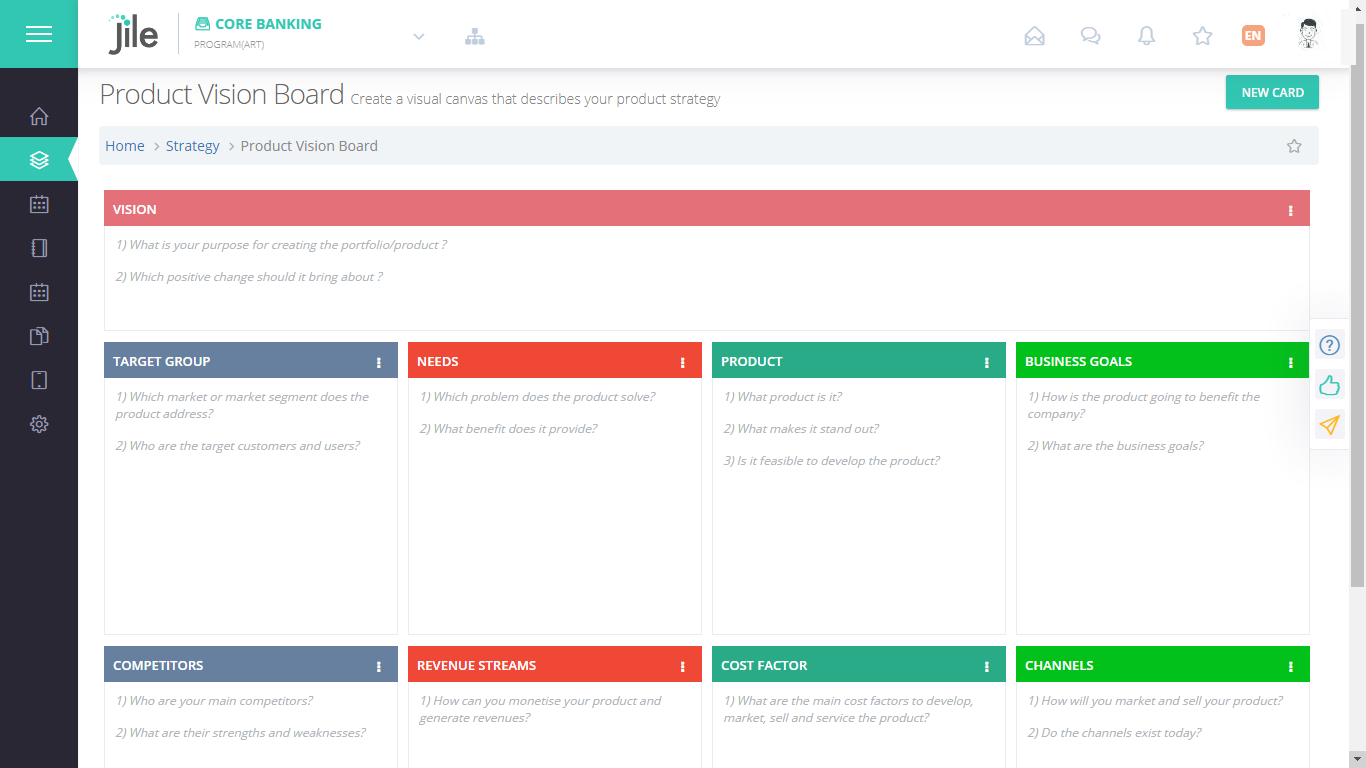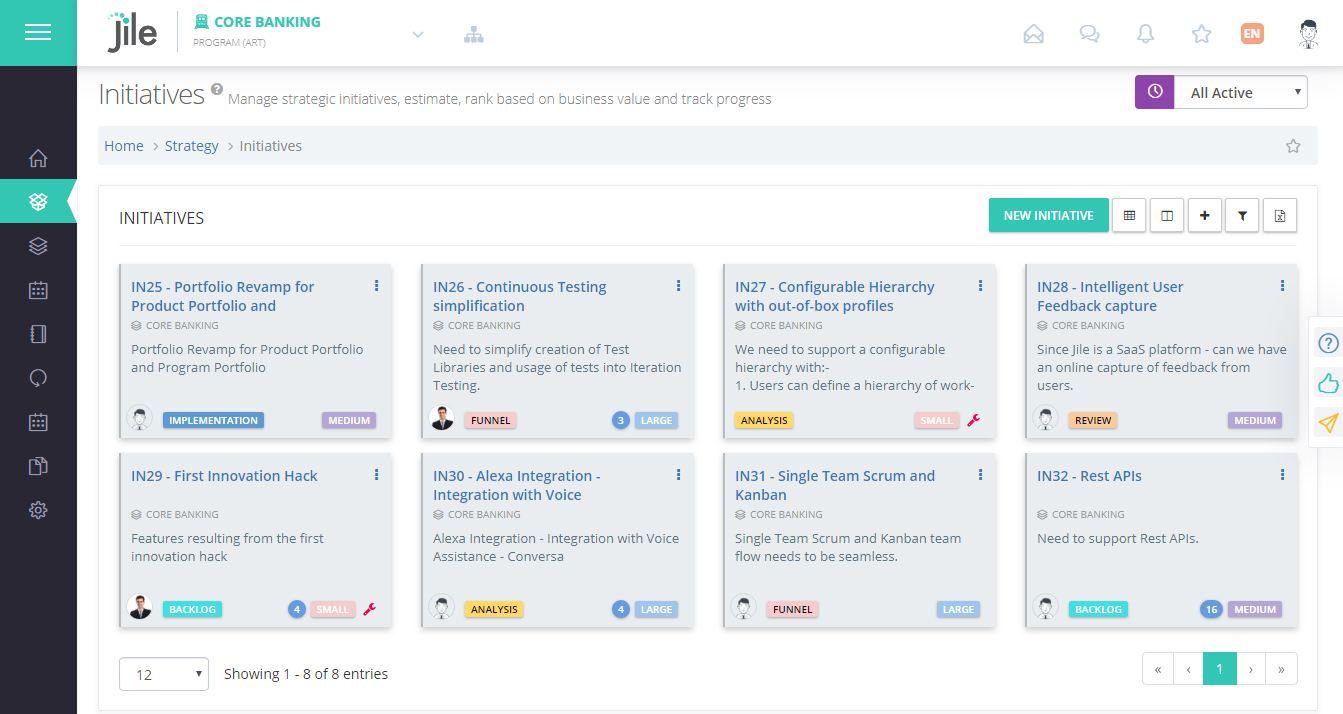Introduction
Strategy defines how an organization plans to achieve its long term vision and create significant value to all its stakeholders. Strategy can be defined at multiple levels starting from an enterprise to a portfolio and all the way for a product. The strategic plan starts with a larger vision which gives the direction which the organization takes. A set of short to medium term business goals or objectives are defined to achieve the vision. Subsequently strategic initiatives are identified and implemented to achieve the objectives and the larger vision
Vision
Vision captures the strategic intent of an enterprise or a portfolio. It provides the long term direction which the organization or the portfolio needs to take to achieve its business goals. Agile teams use different practices and templates like business model canvas, lean canvas etc. to capture and manage the enterprise / portfolio vision and the associated strategy.
Vision Functions
Product Vision Board
Vision Board Function helps the teams to describe, visualize and validate their product strategy in the form of a visual canvas
Business Model Canvas
Business Model Canvas Function helps the teams to document the business model of an enterprise in the form of a visual canvas
Lean Canvas
Lean Canvas Function helps the teams to document the business plan of a lean enterprise in the form of a visual canvas
Objectives
Objectives
Objectives are short to medium term business and product goals that must be achieved by a specified timeline. Objectives help product teams to align their work towards the business and product goals.
Define
Objectives are defined using a brief title, description and a set of key metrics that helps to define the goals using quantifiable parameters. It is recommended to have 3 to 4 key metrics for each objective. One or more Initiatives and associated product backlog are identified to achieving each objective.
Measure
Initiatives and other backlog items associated with the objectives are planned and delivered as part of multiple release and iteration schedules. Business and product management teams continuously log the results against the key metrics and determine if the delivered items help achieve the goal.
Objectives Functions
Objectives
Objectives Function helps the teams to define and track a set of product and business objectives using OKR (Objectives and Key Results Framework)
Objective Attributes
| ID | A Unique identifier with a 2 letter prefix and a sequence number in the form of OB###. ( Note : Workspace Admin can customize the prefix ) |
| Title | Brief Title of the objective |
| Description | Detailed Description of the objective |
| Target | The target time-frame by which this objective needs to be achieved |
| Status | Status of the objective |
| Key Metrics | Quantifiable parameters to measure the objective |
| Results | Actual Results of each metric |
| Tags | Set of labels to group or categorize objectives |
| Entity | DESCRIPTION |
| Initiatives | List of initiatives that will help achieve this objective |
| Capabilities | List of capabilities that will help achieve this objective |
| Features | List of features that will help achieve this objective |
Initiatives
An Initiative is a container for solution development effort large enough to require analysis, a light weight business case and financial approval before implementation. Initiatives forms the root of the backlog hierarchy and contains sub-initiatives, capabilities and features as child items.
Grooming
Initiatives are refined as a part of the backlog refinement process in which the initiatives are sufficiently detailed with acceptance criteria, business value, benefits and a light weight business case. They are further broken down to multiple smaller chunks of module called sub-initiatives / capabilities or features. During the refinement process initiative will go through multiple stages before they can considered Ready for implementation.
Initiatives can be continuously ranked based on business value or any other attribute deemed fit by the portfolio or business owner teams. At any point in time initiatives can be either ranked up or down depending on the changing business needs. The top ranked initiatives are always picked for implementation during the planning process and helps the team to deliver the most important initiative and provide the highest value to its customers.
Planning and Delivery
Initiatives are large solution development effort and cannot fit into a single release schedule. Also they follow a lean start-up build-measure-learn cycle where initiatives are realized incrementally by defining the MVP and continuously evaluated for business outcomes.
When the initiatives are marked as Ready its child capabilities and features are pushed into the product backlog and are available for planning in the release schedules. Based on the available capacity teams pull top features or capabilities from different Ready initiatives and plan them into the release schedule.
Evaluation
Initiatives are continuously evaluated and decisions are made to pivot (stop and move to alternate options) or persevere (continue) or mark an initiative as done based on the outcome and goals met.
Unlike other backlog items like capability / feature or a story not all child items needs to be done for the initiative to be marked as done. Once the initiative achieves its stated goal it can be marked as done.
Initiative Functions
Initiatives
Initiatives Function helps the teams to manage the list of all key initiatives of a product
- Capture information about an initiative like title, description, benefits etc. Estimate the size of an initiative using configurable units Rank the initiative and create a prioritized list Breakdown initiative into one or more features Manage the progress of an initiative using configurable statuses Pivot or persevere an initiative based on defined goals
Initiatives Attributes and Relationships
| ID | A Unique identifier with a 2 letter prefix and a sequence number in the form of IN###. ( Note : Workspace Admin can customize the prefix ) |
| Title | Brief title of the initiative |
| Description | Detailed Description of the initiative |
| Success Criteria | Detailed set of conditions the Initiative has to meet to be considered successful |
| Tags | Set of labels to group or categorize related initiatives |
| Status | Status of the Initiative |
| Ready Date | Date on which the Initiative was marked as Ready for implementation. |
| Type | Feature can be of 2 types.
1. Business - A Business Initiative provides a service that addresses a specific business need. 2. Enabler - Enablers are technical initiatives that support the development of business initiatives |
| Owner | Initiative Owner. (Only Key Members can be tagged as Initiative Owner) |
| Planned Time-frame | Planned Business Time-frame |
| Business Value | Business Value provided by this Initiative. (Note: Workspace Admin can customize the initial list of values for business value. Business value can also be configured to have a calculator control based on a set of attributes values defined by the administrator ) |
| Initial Estimate | Initial Size Estimate of the Initiative. (Workspace Admin can customize the initial estimate values. Initial Estimate value can also be configured to have a calculator control based on a set of attributes values defined by the administrator) |
| Story Estimate | Rolled up estimate points of all the Stories tagged to this Initiative. (Note: Initiatives can be broken down into product capabilities and features and subsequently into product stories which are estimated in points.) |
| Evaluation Decision | Captures the decision taken during the periodic review of the initiatives. Initiatives can be either marked as pivoted, perservered or completed |
| Entity | DESCRIPTION |
| Objectives | The Objective or the goal this initiative addresses |
| Capabilities | List of all child capabilities of this initiative |
| Features | List of all child features of this initiative |




